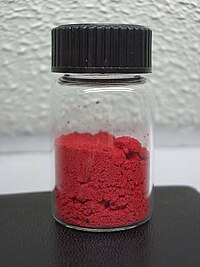Cadmium selenide
 |
|
 |
|
| Names | |
|---|---|
|
IUPAC name
Selanylidenecadmium
|
|
| Other names | |
| Identifiers | |
|
1306-24-7 |
|
| 3D model (Jmol) | Interactive image |
| ChEBI |
CHEBI:50834 |
| ChemSpider |
14101 |
| ECHA InfoCard | 100.013.772 |
| EC Number | 215-148-3 |
| 13656 | |
| MeSH | cadmium+selenide |
| PubChem | 14784 |
| RTECS number | EV2300000 |
| UN number | 2570 |
|
|
|
|
| Properties | |
| CdSe | |
| Molar mass | 191.39 g·mol−1 |
| Appearance | Black, translucent, adamantine crystals |
| Odor | Odorless |
| Density | 5.816 g cm−3 |
| Melting point | 1,268 °C; 2,314 °F; 1,541 K |
| Band gap | 1.74 eV |
|
Refractive index (nD)
|
2.5 |
| Structure | |
| Wurtzite | |
| C6v4-P63mc | |
| Hexagonal | |
| Hazards | |
| GHS pictograms |
  
|
| GHS signal word | DANGER |
| H301, H312, H331, H373, H410 | |
| P261, P273, P280, P301+310, P311, P501 | |
|
EU classification (DSD)
|
|
| R-phrases | R20/21/22, R23/25, R33, R50/53 |
| S-phrases | (S2), S36/37, S45, S60, S61 |
| US health exposure limits (NIOSH): | |
|
PEL (Permissible)
|
[1910.1027] TWA 0.005 mg/m3 (as Cd) |
|
REL (Recommended)
|
Ca |
|
IDLH (Immediate danger)
|
Ca [9 mg/m3 (as Cd)] |
| Related compounds | |
|
Other anions
|
Cadmium oxide, Cadmium sulfide, Cadmium telluride |
|
Other cations
|
Zinc selenide, Mercury(II) selenide |
|
Except where otherwise noted, data are given for materials in their standard state (at 25 °C [77 °F], 100 kPa).
|
|
|
|
|
| Infobox references | |
Cadmium selenide is an inorganic compound with the formula CdSe. It is a black to red-black solid that is classified as a II-VI semiconductor of the n-type. Much of the current research on cadmium selenide is focused on its nanoparticles.
Three crystalline forms of CdSe are known: wurtzite (hexagonal), sphalerite (cubic) and rock-salt (cubic). The sphalerite CdSe structure is unstable and converts to the wurtzite form upon moderate heating. The transition starts at about 130 °C, and at 700 °C it completes within a day. The rock-salt structure is only observed under high pressure.
The production of cadmium selenide has been carried out in two different ways. The preparation of bulk crystalline CdSe is done by the High-Pressure Vertical Bridgman method or High-Pressure Vertical Zone Melting.
Cadmium selenide may also be produced in the form of nanoparticles. (see applications for explanation) Several methods for the production of CdSe nanoparticles have been developed: arrested precipitation in solution, synthesis in structured media, high temperature pyrolysis, sonochemical, and radiolytic methods are just a few.
Production of cadmium selenide by arrested precipitation in solution is performed by introducing alkylcadmium and trioctylphosphine selenide (TOPSe) precursors into a heated solvent under controlled conditions.
CdSe nanoparticles can be modified by production of two phase materials with ZnS coatings. The surfaces can be further modified, e.g. with mercaptoacetic acid, to confer solubility.
Synthesis in structured environments refers to the production of cadmium selenide in liquid crystal or surfactant solutions. The addition of surfactants to solutions often results in a phase change in the solution leading to a liquid crystallinity. A liquid crystal is similar to a solid crystal in that the solution has long range translational order. Examples of this ordering are layered alternating sheets of solution and surfactant, micelles, or even a hexagonal arrangement of rods.
...
Wikipedia
